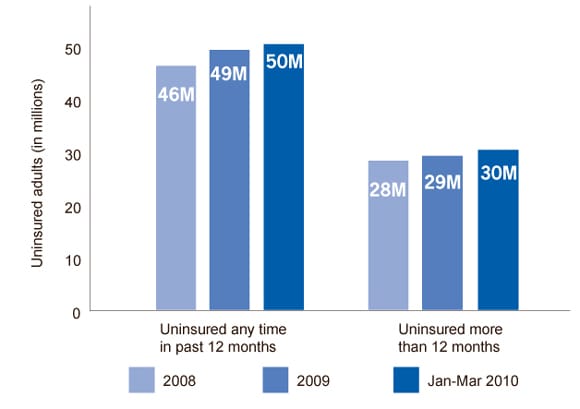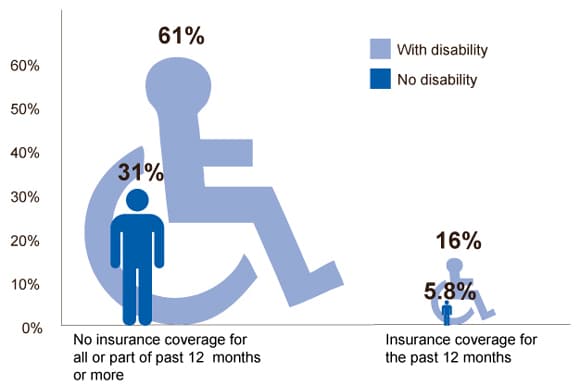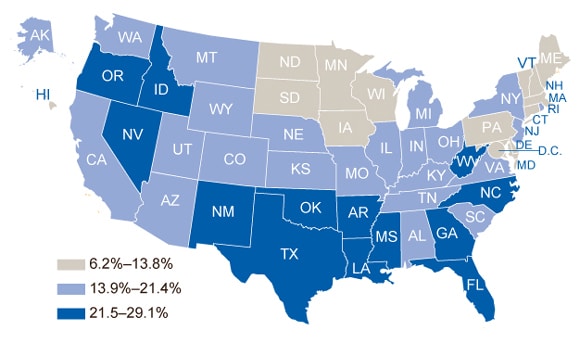Access to Health Care
A record number of adults 18–64 years old are uninsured
November 2010



1 in 4
About 25 percent of adults 18–64 years old report being uninsured for at least part of the past 12 months (January-March 2010 survey).

1 in 3
About 32 percent of adults 18–64 years old living in middle-income households report being uninsured for at least part of the past 12 months (2009 survey)*.

7x
Adults 18-64 years old with no health insurance at all in the past 12 months were 7 times more likely to skip medical care for cost reasons, compared with those continuously insured (2009 survey).
New 2010 estimates show that the number of Americans without health insurance is growing, affecting middle-income Americans as well as those living in poverty. About 50 million adults 18–64 years old had no health insurance for at least some of the past 12 months. People in all income brackets have been affected, not just adults living in poverty, according to a 2009 survey. In the past few years, the number of adults aged 18–64 who went without health insurance for at least part of the past 12 months increased by an average of 1.1 million per year. About half of those additional adults were middle-income.* Adults without consistent health insurance are more likely to skip medical care because of cost concerns, which can lead to poorer health, higher long-term health care costs, and early death.
*About $43,000–$65,000 household income for a household of four
The number of adults 18–64 years old without health insurance is high and continues to rise.
More adults 18–64 years old went without health insurance than ever before.
- About 1 in 4 adults this age (about 50 million) reported not having health insurance for at least part of the past 12 months.
- About 1 in 6 adults this age (about 30 million) went without health insurance for the past 12 months or longer.
- During each of the past few years, the number of adults this age who went without health insurance for at least part of the past 12 months increased by an average of 1.1 million.
- More than half of adults this age without health insurance for more than the past 12 months had no usual source of medical care.
Adults 18–64 years old without health insurance, 2008–2010 (Jan-Mar)

SOURCE: National Health Interview Survey, Jan-Mar 2010.
Adults 18–64 years old who have a chronic illness and who do not have health insurance are more likely to skip or delay medical care because of cost.
- 40% of the entire US population has one or more chronic illnesses.
- Currently insured adults this age with a chronic illness who recently had even a short gap in health insurance coverage were 3 times as likely to skip medical care because of cost compared to those continuously insured.
- More than 40% of adults this age without health insurance in the past 12 months who had high blood pressure, asthma, or diabetes reported in 2009 that they had skipped care because of cost.
- Delays in health care can lead to poorer health and higher medical costs over time.
Adults 18–64 years old with a disability skipped or delayed some medical care in the past 12 months because of cost.
- Almost 1 in 4 (46 million) adults this age in the US have a disability.
- About 30% of adults this age with a disability reported in 2009 that they had no health insurance in the past 12 months.
- Overall, disabled persons were about twice as likely as those with no disability to skip or delay medical care. About 60% of adults this age with a disability who had recent gaps in the past 12 months in their insurance skipped or delayed medical care, compared with only 16% for those with continuous insurance coverage.
Percentage of adults 18–64 years old who skipped or delayed medical care because of cost, by disability* and insurance coverage status

*Disability status is based on Basic Actions Difficulty, which involves movement, vision, hearing, emotional upset, and difficulty remembering or being confused, as defined by Altman and Bernstein 2008. See http://www.cdc.gov/nchs/data/misc/disability2001-2005.pdf [PDF – 859 KB], pp.75-77.
SOURCE: National Health Interview Survey, 2009. Available at http://www.cdc.gov/nchs/nhis.htm. Reprinted from MMWR 2010;59(44).
The percentage of currently uninsured adults, 18–64 years old, varies by state, ranging from 6% in Massachusetts, where there are strong state policies on coverage, to 29% in Texas.
Percentage of adults 18–64 years old without health insurance at the time of interview — 2009 Behavioral Risk Factor Surveillance System, US

The Affordable Care Act
- Is projected to extend health insurance for up to 94% of people below 65 years old (an additional 32 million people) by 2019.
- Can reduce skipped or delayed care because people are less likely to have gaps in insurance.
- Requires insurance plans to cover and not charge co-payments for effective preventive services. Greater use of these services could save 100,000 lives each year.
Everyone can
- Get healthy. Eat less sugar, salt and saturated fats and more fruits and vegetables. Walk 30 minutes a day. Quit smoking, or don’t start.
- Stay healthy. Take any medicines your doctor has prescribed. Talk to your doctor about medication programs that help people with low incomes if you can’t afford your medicine.
- Sign up for health insurance. Even if you have a pre-existing condition, health insurance is now available in some states.
- Go see your main health care provider. Your primary care doctor, nurse practitioner, or physician assistant can make sure that you are up-to-date with preventive services such as immunizations, as well as cholesterol, mental health, and cancer screenings. Also, they can help prevent costly and disabling complications such as strokes and heart attacks.
- Find your options for health care you can receive right now. See http://www.hrsa.gov/gethealthcare/index.html and http://www.healthcare.gov.
Employers can
- Provide comprehensive wellness programs for employees that include physical activity and other wellness measures.
- Provide options that make health insurance and health care easier to afford for employees. These options should include basic primary care and prevention.
Health care providers can
- Include at least some preventive care at each patient visit.
- Support the use of retail sites, schools, churches, and community centers to make it more convenient for people to get basic primary care and prevention, including vaccinations.
Health insurance plans can
- Promote healthy diet and physical activity for their enrollees. Adults who are overweight or have high blood pressure, high cholesterol, or diabetes are more likely to have higher health care costs.
- Provide basic primary care and prevention services in more convenient locations such as retail sites, schools, churches, and community centers.
